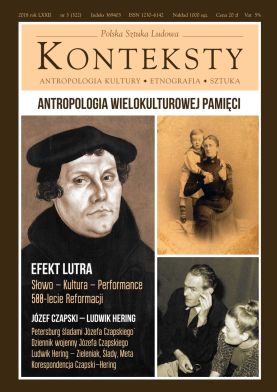Architektura sakralna wyznawców Ewangelii na tle rozwoju Reformacji w wieku XVII i XVIII
Sacral Architecture of the Evangelists against the Backdrop of the Progress of the Reformation in the Seventeenth and Eighteenth Century
Author(s): Piotr Sypczuk, Andrzej Józef Baranowski, Piotr LasekSubject(s): Geography, Regional studies, Theology and Religion
Published by: Instytut Sztuki Polskiej Akademii Nauk
Keywords: Reformation;Luther;architecture
Summary/Abstract: A photographic exhibition: “Churches of the Reformation in the Lens of Piotr Drewniak” was opened on 5 December 2017 at the Institute of Art of the Polish Academy of Sciences to mark the 500th anniversary of the Reformation. The author of the photographs works at the institute of Art and in addition specializes in artistic and documentary photography. The exhibition featured selected objects of architecture and artworks associated with the emergence and progress of the Reformation in Saxony, Silesia, Prussia, Greater Poland, and the Grand Duchy of Lithuania. The exposition was accompanied by a scientific seminar about 500 years of the Reformation. The debates focused on the sacral architecture of reformed creeds - its transformations as well as mutual relations and impact. Among the former provinces of the Commonwealth the most conspicuous and longest-lasting Protestant character was maintained in Greater Poland. The earliest among the dissident communes were the Bohemian Brethren, whose monumental church was erected at the end of the sixteenth century in Krotoszyn. The second Protestant current was Lutheranism, which reached Greater Poland mainly from Saxony and Royal Prussia. The Protestant attitude towards church architecture differed from that of Catholicism. The architectural form was determined not by the symbolism of the building but by the components of serving God, predominantly the sermon. Greatest attention was paid to the uniformity of the interior, good acoustics, and visibility from all parts of the church so that members of the congregation could enjoy simultaneous contact with the altar, the pulpit, and the music choir. Martin Luther opened the first Protestant church at the Hertenfels ducal castle in Torgau already on 5 October 1544. The propaganda resonance of the Torgau church became the reason why it turned into a proptype of successive castle chapels in the Reich. Pioneering projects appeared the moment theoretical reflections started dealing with Protestant architecture (e.g. the church in Waltershausen, designed by Wolf Christoph Zorn von Plobsheim from Gotha or the realised projects of Georg Behr and his student Johann Georg Schmidt from the Dresden milieu). The confrontation of the Reformation and the Counter-Reformation did not produce a crisis in art. Both sides employed the most outstanding artists who executed works featuring common features and whose formal diversity still conceals assorted classification problems.
Journal: Konteksty
- Issue Year: 322/2018
- Issue No: 3
- Page Range: 12-21
- Page Count: 10
- Language: Polish
- Content File-PDF

